Gliding

Gliding is a recreational activity and competitive sport in which pilots fly un-powered aircraft known as gliders or sailplanes. Properly, the term gliding refers to descending flight of a heavier-than-air craft, whereas soaring is the correct term to use when the craft gains altitude or speed from rising air.[1] When soaring conditions are good enough, experienced pilots can fly hundreds of kilometres before returning to their home airfields, and occasionally flights over 1,000 kilometres are made.[2] However, if the weather deteriorates, they may need to land elsewhere, but motorglider pilots can avoid this by starting an engine.
While many glider pilots merely enjoy the sense of achievement, some competitive pilots fly in races around pre-defined courses. These competitions test the pilots' abilities to make best use of local weather conditions as well as their flying skills. Local and national competitions are organized in many countries and there are also biennial World Gliding Championships.[3]
Powered aircraft and winches are the two most common means of launching gliders. These and other methods (apart from self-launching motor-gliders) require assistance from other participants. Gliding clubs have thus been established to share airfields and equipment, train new pilots and maintain high safety standards.
Contents |
History
The development of heavier-than-air flight in the half-century between Sir George Cayley's coachman in 1853 and the Wright brothers mainly involved gliders (see aviation history). However, the sport of gliding only emerged after the First World War as a result of the Treaty of Versailles,[4] which imposed severe restrictions on the manufacture and use of single-seat powered aircraft in Germany. Thus, in the 1920s and 1930s, while aviators and aircraft makers in the rest of the world were working to improve the performance of powered aircraft, the Germans were designing, developing and flying ever more efficient gliders and discovering ways of using the natural forces in the atmosphere to make them fly farther and faster. The active support of the government ensured a ready supply of experienced aviators ready to be trained in warplane operation when the treaty was abrogated in preparation for World War II by the Third Reich - though for most of the participants, their sport had no military overtones.
The first German gliding competition was held at the Wasserkuppe[5] in 1920,[6] organized by Oskar Ursinus. The best flight lasted two minutes and set a world distance record of 2 km.[6] Within ten years, it had become an international event in which the achieved durations and distances had increased greatly. In 1931, Gunther Grönhoff flew 272 km (169 miles) from Munich to Czechoslovakia, further than had been thought possible.[6]

In the 1930s, gliding spread to many other countries. In the 1936 Summer Olympics in Berlin gliding was a demonstration sport, and it was scheduled to be a full Olympic sport in the 1940 Games. A glider, the Olympia, was developed in Germany for the event, but World War II intervened. By 1939 the major gliding records were held by Russians, including a distance record of 748 km (465 miles).[6]
During the war, civilian gliding in Europe was largely suspended. Although some military operations in WWII involved military gliders, they did not soar and so are unrelated to the sport of gliding. Nonetheless, several German fighter aces in the conflict, including Erich Hartmann, began their flight training in gliders.
Gliding did not return to the Olympics after the war, for two reasons: first, the shortage of gliders following the war; and second, the failure to agree on a single model of competition glider. (Some in the community feared doing so would hinder development of new designs.)[6] The re-introduction of air sports such as gliding to the Olympics has been occasionally proposed by the world governing body, the FAI, but this has been rejected on the grounds of lack of public interest.[7]
In many countries during the 1950s a large number of trained pilots wanted to continue flying. Many were also aeronautical engineers. They started both clubs and manufacturers, many of which still exist. This stimulated the development of both gliding and gliders; for example, the Soaring Society of America grew from 1,000 members then to its present total of 12,500. The increased numbers of pilots, greater knowledge and improving technology helped set new records, so that the pre-war altitude record was doubled by 1950, and the first 1,000 km (621 statute miles) flight was achieved in 1964.[6] New materials such as glass fiber and carbon fiber, advances in wing shapes and airfoils, electronic instruments, GPS and improved weather forecasting have since allowed many pilots to make flights that were once extraordinary. Today over 500 pilots have made flights over 1,000 km.[8]
Instead of Olympic competition there are the World Gliding Championships. The first event was held at the Wasserkuppe in 1937.[6] Since WWII it has been held every two years. There are now six classes open to both sexes, plus three classes for women and two junior classes. Germany, the sport's birthplace, is still a center of the gliding world: it accounts for 30% of the world's glider pilots,[9] and the three major glider manufacturers are still based there. However the sport has been taken up in many countries and there are now over 116,000 active glider pilots,[10] plus an unknown number of military cadets. Each year many other people experience their first glider flight. It does not matter whether the countries are flat or mountainous, hot or temperate, because gliders can soar in most places.
Soaring

Glider pilots can stay airborne for hours by flying through air that is ascending as fast or faster than the glider itself is descending, thus gaining potential energy.[11] The most commonly used sources of rising air are
- thermals (updrafts of warm air);
- ridge lift (found where the wind blows against the face of a hill and is forced to rise); and
- wave lift (standing waves in the atmosphere, analogous to the ripples on the surface of a stream).
Ridge lift rarely allows pilots to climb much higher than about 600 m (2,000 ft) above the terrain; thermals, depending on the climate and terrain, can allow climbs in excess of 3,000 m (10,000 ft) in flat country and much higher above mountains;[12] wave lift has allowed a glider to reach an altitude of 15,447 m (50,671 ft).[13] In a few countries, gliders may continue to climb into the clouds in uncontrolled airspace, but in many countries the pilot must stop climbing before reaching the cloud base (see Visual Flight Rules).
Thermals
Thermals are streams of rising air that are formed on the ground through the warming of the surface by sunlight.[14] If the air contains enough moisture, the water will condense from the rising air and form cumulus clouds. Once a thermal is encountered, the pilot usually flies in circles to keep the glider within the thermal, so gaining altitude before flying off to the next thermal and towards the destination. This is known as "thermalling". Climb rates depend on conditions, but rates of several meters per second are common. Thermals can also be formed in a line usually because of the wind or the terrain, creating cloud streets. These can allow the pilot to fly straight while climbing in continuous lift.
When the air has little moisture or when an inversion stops the warm air from rising high enough for the moisture to condense, thermals do not create cumulus clouds. Without clouds or dust devils to mark the thermals, the pilot must use his skill and luck to find them using a sensitive vertical speed indicator called a variometer that quickly indicates climbs or descents. Typical locations to find thermals are over towns, freshly ploughed fields and asphalt roads, but thermals are often hard to associate with any feature on the ground. Occasionally thermals are caused by the exhaust gases from power stations or by fires.
As it requires rising heated air, thermalling is only effective in mid-latitudes from spring through into late summer. During winter the solar heat can only create weak thermals, but ridge and wave lift can still be used during this period.
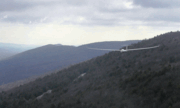
Ridge lift
A ridge soaring pilot uses air lifted up the sides of hills. It can also be augmented by thermals when the slopes also face the sun.[15] In places where a steady wind blows, a ridge may allow virtually unlimited time aloft, though records for duration are no longer recognized because of the danger of exhaustion.[16]
Wave lift
The powerfully rising and sinking air in mountain waves was discovered by a glider pilot, Wolf Hirth, in 1933.[17] Gliders can sometimes climb in these waves to great altitudes, though pilots must use supplementary oxygen to avoid hypoxia.

This lift is often marked by long, stationary lenticular (lens-shaped) clouds lying perpendicular to the wind.[18] Mountain wave was used to set the current altitude record of 50,699 feet (15,453 m) on August 29, 2006 over El Calafate, Argentina. The pilots were Steve Fossett and Einar Enevoldson, who were wearing pressure suits.[19] The current world distance record of 3,008 km (1,869 statute miles) by Klaus Ohlmann (set on 21 January 2003)[20] was also flown using mountain waves in South America.
A rare wave phenomenon is known as Morning Glory, a roll cloud producing strong lift. Pilots near Australia's Gulf of Carpentaria make use of it in springtime.[21]
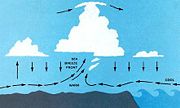
Other sources of lift
The boundaries where two air masses meet are known as convergence zones.[22] These can occur in sea breezes or in desert regions. In a sea-breeze front, cold air from the sea meets the warmer air from the land and creates a boundary like a shallow cold front. Glider pilots can gain altitude by flying along the intersection as if it were a ridge of land. Convergence may occur over considerable distances and so may permit virtually straight flight while climbing.
Glider pilots have been able to use a technique called "dynamic soaring",[23] where a glider can gain kinetic energy by repeatedly crossing the boundary between air masses of different horizontal velocity. However, such zones of high "wind gradient" are usually too close to the ground to be used safely by gliders.
Launch methods
Gliders, not having engines, use various methods to take off. Glider pilots who want to use the different types of launch methods must be in current practice in each. Licensing rules in some countries differentiate between aerotows and ground launch methods, due to the widely different techniques.
Aerotowing
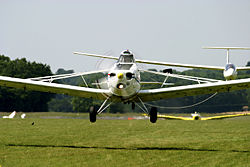
Aerotows normally use single-engined light aircraft, although motor gliders have also been permitted to tow gliders. The tow-plane takes the glider to the desired height and place where the glider pilot releases the rope.[24] A weak link is often fitted to the rope to ensure that any sudden loads do not damage the airframe of the tow-plane.
During the aerotow, the glider pilot keeps the glider in one of two positions behind the tow-plane.[25] This position can either be the "low tow" position, just below the wake from the tow-plane, or the "high tow" position just above the wake.[26] In Australia the convention is to fly in low tow, whereas in the United States and Europe the high tow prevails.[27] One aerotow variation is to attach two gliders to one tow-plane, using a short rope for the high towed glider and the long rope for the low tow.
Wire launching
Winch-launching
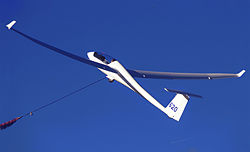
Gliders are often launched using a stationary ground-based winch mounted on a heavy vehicle.[28] This method is widely used at many European clubs, often in addition to aerotowing. The engine is usually a large diesel, though hydraulic fluid engines and electrical motors are also used. The winch pulls in a 1,000 to 1,600 m (3,000 to 5,500-foot) cable, made of high-tensile steel wire or a synthetic fiber, attached to the glider. The cable is released at a height of about 400 to 700 m (1,300 to 2,200 feet) after a short and steep ride.

The main advantage of a winch launch is its lower cost, but the launch height is usually lower than an aerotow, so flights are shorter unless the pilot can quickly make contact with a source of lift within a few minutes of releasing the cable. Although there is a risk of the cable breaking during this type of launch, pilots are trained to deal with this.
Auto-tow
Another launch method, the "autotow", is rarer nowadays.[29] The direct towing method requires a hard surface, a powerful vehicle and a long steel cable. After gently taking up slack in the cable, the driver accelerates hard and the glider rises like a kite to as much as 400 m (1300 ft) if there is a good headwind and a runway of 1.5 km (1 mile) or more. This method has also been used on desert dry lakes.
A variation on this is the "reverse pulley" method in which the truck drives towards the glider that it is launching with the cable passing around a pulley at the far end of the airfield, with an effect similar to a winch launch.
Bungee launch
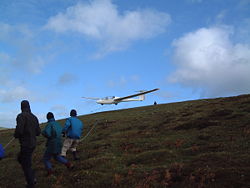
Bungee launching was widely used in the early days of gliding, and occasionally gliders are still launched from the top of a gently sloping hill into a strong breeze using a substantial multi-stranded rubber band, or "bungee".[30] For this launch method, the glider's main wheel rests in a small concrete trough. The hook normally used for winch-launching is instead attached to the middle of the bungee. Each end is then pulled by three or four people. One group runs slightly to the left, the other to the right. Once the tension in the bungee is high enough, the pilot releases the wheel brake and the glider's wheel pops out of the trough. The glider gains just enough energy to leave the ground and fly away from the hill.
Cross-country

The distance that a glider can fly for each meter it descends is expressed as its lift-to-drag ratio (L/D). Depending on the class, this can be between 44:1 and 70:1 in modern designs. This performance combined with regular sources of rising air enables gliders to fly long distances at high speeds.[31] The record average speed for 1,000 km is 169.7 km/h (621 statute miles at 105 miles/h).[32] Even in places with less favorable conditions (such as Northern Europe) most skilled pilots complete flights over 500 km (310 miles) every year.[33]
Glider pilots are required to stay within gliding range of their home airfield for their early solo flights as student pilots. Cross-country flights are allowed when they have sufficient experience to find sources of lift away from their home airfield, to navigate and to land elsewhere if necessary. As the performance of gliders improved in the 1960s, the concept of flying as far away as possible became unpopular with the crews who had to retrieve the gliders. Pilots now usually plan to fly around a course (called a task) via turn-points, returning to the starting point.
In addition to just trying to fly further, glider pilots also race each other in competitions.[34] The winner is the fastest, or, if the weather conditions are poor, the furthest round the course. Tasks of up to 1,000 km have been set[35] and average speeds of 120 km/h are not unusual.
Initially, ground observers confirmed that pilots had rounded the turn-points. Later, the glider pilots photographed these places and submitted the film for verification. Today, gliders carry secure GNSS Flight Recorders that record the position every few seconds from GPS satellites.[36] These recording devices now provide the proof that the turn-points have been reached.
National competitions generally last one week, with international championships running over two. The winner is the pilot who has amassed the greatest number of points over all the contest days. However, these competitions have as yet failed to draw much interest outside the gliding community for several reasons. Because it would be unsafe for many gliders to cross a start line at the same time, pilots can choose their own start time. Furthermore, gliders are not visible to the spectators for long periods during each day's contest and the scoring is complex, so gliding competitions have been difficult to televise.
In an attempt to widen the sport's appeal, a new format, the Grand Prix, has been introduced.[37] Innovations introduced in the Grand Prix format include simultaneous starts for a small number of gliders, tasks consisting of multiple circuits, and simplified scoring. There is decentralized Internet based competition called the Online Contest[38] where pilots upload their GPS data files and are automatically scored based on distance flown. 7,800 pilots worldwide participated in this contest in 2006.[39]
Maximizing average speed
Soaring pioneer Paul MacCready is usually credited with developing a mathematical theory for optimizing the speed to fly when cross-country soaring,[40] though it was first described by Wolfgang Späte (who later became famous for flying Messerschmitt Me 163 Komet rocket fighters with the Luftwaffe late in World War II) in 1938.[41] The speed to fly theory allows the optimal cruising speed between thermals to be computed, using thermal strength, glider performance and other variables. It accounts for the fact that if a pilot flies faster between thermals, the next thermal is reached sooner. However at higher speeds the glider also sinks faster, requiring the pilot to spend more time circling to regain the altitude. The MacCready speed represents the optimal trade-off between cruising and circling. Most competition pilots use MacCready theory to optimize their average speeds, and have the calculations programmed in their flight computers. The greatest factor in maximizing average speed, however, remains the ability of the pilot to find the strongest lift.[42]
On cross-country flights where strong lift is forecast, pilots fly with water ballast stored in tanks or bags in the wings and fin. The fin tank is used to reduce trim drag by optimizing the center of gravity, which typically would shift forward if water is stored only in the wings ahead of the spar.[43] Ballast enables a sailplane to attain its best L/D at higher speeds but slows its climb rate in thermals, in part because a sailplane with a heavier wing loading cannot circle within a thermal as tightly as one with a lower, unballasted wing loading. But if lift is strong, typically either from thermals or wave, the disadvantage of slower climbs is outweighed by the higher cruising speeds between lift areas. Thus, the pilot can improve the average speed over a course by several percent or achieve longer distances in a given time.[43] If lift is weaker than expected, or if an off-field landing is imminent, the pilot can jettison the water ballast by opening the dump valves.
Badges
Achievements in gliding have been marked by the awarding of badges since the 1920s.[44] For the lower badges, such as the first solo flight, national gliding federations set their own criteria. Typically, a bronze badge shows preparation for cross-country flight, including precise landings and witnessed soaring flights. Higher badges follow the standards set down by the Gliding Commission of the Fédération Aéronautique Internationale (FAI).[45] The FAI's Sporting Code defines the rules for observers and recording devices to validate the claims for badges, which are defined by kilometers of distance and meters of altitude gained.[46] The Silver-C badge was introduced in 1930.[44] Earning the Silver Badge shows that a glider pilot has achieved an altitude gain of at least 1,000 m, made a five-hour duration flight, and has flown cross-country for a straight-line distance of at least 50 km: these three attainments are usually, but not invariably, achieved in separate flights. The Gold and Diamond Badges require pilots to fly higher and further. A pilot who has completed the three parts of the Diamond Badge has flown 300 km to a pre-defined goal, has flown 500 km in one flight (but not necessarily to a pre-defined goal) and gained 5,000 m in height. The FAI also issues a diploma for a flight of 1,000 km and further diplomas for increments of 250 km.
Landing out

If lift is not found during a cross-country flight, for example because of deteriorating weather, the pilot must choose a field and 'land out'.[47] Although inconvenient and often mistaken for "emergency landings", landing out (or "outlanding") is a routine event in cross-country gliding. The pilot has to choose a field where the glider can be landed safely, without damaging property such as crops or livestock.[48]
The glider and the pilot(s) can be retrieved from the field using a purpose-built trailer. Alternatively, if the glider has landed in a suitable field, a tow-plane can be summoned to re-launch the aircraft (as long as the property owner gives permission). The glider pilot typically pays for the time the tow-plane is in the air, both to and from the field, so this alternative can become expensive.
Use of engines or motors

Although adding to the weight and expense, some gliders are fitted with small power units and are known as motor gliders. This avoids the inconvenience of landing out. The power units can be internal combustion engines, electrical motors , or retractable jet engines. Retractable propellers are fitted to high performance sailplanes, though in another category, called touring motor gliders, non-retractable propellers are used. Some powered gliders are 'self launching,' which makes the glider independent of a tow plane. However some gliders have 'sustainer' engines which can prolong flight but are not powerful enough for launching.
All power units have to be started at a height that includes a margin that would still allow a safe landing-out to be made, if there were a failure to start.[49] In a competition, using the engine ends the soaring flight. Unpowered gliders are lighter and, as they do not need a safety margin for starting the engine, they can safely thermal at lower altitudes in weaker conditions. Consequently, pilots in unpowered gliders may complete competition flights when some powered competitors cannot.[50] Conversely, motor glider pilots can start the engine if conditions will no longer support soaring flight, while unpowered gliders will have to land out, away from the home airfield, requiring retrieval by road using the glider's trailer. Opinions differ whether difficult flights, where an engine was always available, are as satisfying as flights in pure gliders.
Aerobatics
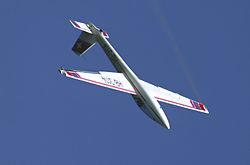
Aerobatic competitions are held regularly.[51] In this type of competition, the pilots fly a program of maneuvers (such as inverted flight, loop, roll, and various combinations). Each maneuver has a rating called the "K-Factor".[52] Maximum points are given for the maneuver if it is flown perfectly; otherwise, points are deducted. Efficient maneuvers also enable the whole program to be completed with the height available. The winner is the pilot with the most points.
Hazards
Gliders, unlike hang gliders and paragliders, surround the pilot with a strong structure, so most accidents cause no injuries,[53] but there are some hazards.[54] Though training and safe procedures are central to the ethos of the sport, a few fatal accidents occur every year, almost all caused by pilot error.[53] In particular there is a risk[55] of mid-air collisions between gliders, because two pilots might choose to fly to the same area of lift and so might collide. Because of this risk, pilots usually wear parachutes. To avoid other gliders and general aviation traffic, pilots must comply with the Rules of the Air and keep a good lookout. In several European countries and Australia, the FLARM warning system is used to help avoid mid-air collisions between gliders.[56]
Challenges for the gliding movement
Gliding as a sport faces challenges in the years ahead.[57] These include:
- Time pressures on participants: gliding typically takes whole days, which many people today find harder to devote. As a result the average age of glider pilots is increasing
- Airspace: in many European countries the growth of civil aviation is reducing the amount of uncontrolled airspace
- Competition from other activities: there is now a greater variety of similar sports such as hang gliding and paragliding that may attract potential glider pilots.
- Lack of publicity: without coverage by television, many people are unaware of competitive gliding.
- Increasing costs, due to higher costs of fuel and insurance, and due to greater regulation requiring equipment such as new radios or transponders.
Learning to glide

Most clubs offer trial lessons to people interested in learning to glide. National gliding associations have contact details for their member clubs. Because most gliders are designed to the same specifications of safety, the upper weight limit for pilots, after allowing for a parachute, is usually 103 kg (228 pounds). People over 193 cm (6’ 4’’) will also have problems. The pupil flies with an instructor in a two-seat glider fitted with dual controls.[58] The instructor performs the first launches and landings, typically from the back seat, but otherwise the pupil manages the controls. Some clubs offer courses over several days, with a mixture of winch and aerotow launches. It may take ab initios at least 50 training flights before they are deemed to have the skill and the airmanship necessary to fly solo.[59]
If winches are used, the cost of learning to glide is much less than that of learning to fly powered aircraft. Training using aerotow costs more than using winches, though fewer launches (as few as 25) might be needed. Simulators are also beginning to be used in training, especially during poor weather.
After the first solo flight, further training with an instructor continues until the pupil is capable of taking a glider cross-country. In most countries pilots must sit examinations on the regulations, navigation, use of the radio, weather, principles of flight and human factors.
Related air sports
Most hang gliders are simpler and cheaper aircraft which pilots control by shifting body weight. These types have no protective structure around the pilot nor do they have an undercarriage. However, the dividing line between basic gliders and sophisticated hang-gliders is becoming less distinct. For example hang gliders typically use fabric wings, shaped over a framework, but hang gliders with rigid wings and three-axis controls are also available. The lower air speeds and lower glide ratios of typical hang gliders means that shorter cross-country distances are flown than in modern gliders. Paragliders are more basic craft. Their wings usually have no frames and their shape is created by the flow and pressure of air. The airspeed and glide ratio of paragliders are generally lower still than the averages found in hang gliders, and so their cross-country flights are even shorter. Radio-controlled gliding uses scale-models of gliders mainly for ridge soaring; however thermic aeromodelling craft are also used.
See also
- Glider
- Sailplane
- FAI Gliding Commission (includes major gliding records)
- Hang gliding
- Wingsuit flying
- Motor glider
- Powered hang glider
- Gliding competitions
- List of notable glider pilots
- National gliding associations
- Flying and gliding animals
- Paper glider
References
- ↑ "Frequently asked questions about gliding" (PDF). Retrieved on 2006-08-24.
- ↑ "Gliding World Records". Retrieved on 2006-12-21.
- ↑ "Information about gliding competitions" (PDF). Retrieved on 2006-08-24.
- ↑ "History of gliding" (PDF). Retrieved on 2006-08-24.
- ↑ "Wasserkuppe, gliding and model gliding". Retrieved on 2006-09-28.
- ↑ 6.0 6.1 6.2 6.3 6.4 6.5 6.6 Welch, Ann (1980). The Story of Gliding 2nd edition. John Murray. ISBN 0-7195-3659-6.
- ↑ "FAI the Olympics". Retrieved on 2006-08-24.
- ↑ "List of pilots who have flown over 1,000 km". Retrieved on 2006-09-28.
- ↑ "FAI membership summary". Retrieved on 2006-08-24.
- ↑ "FAI membership summary". Retrieved on 2006-08-24.
- ↑ "Visual explanation of soaring". Retrieved on 2006-08-24.
- ↑ "Mountain flying". Retrieved on 2006-09-14.
- ↑ "Altitude record". Retrieved on 2006-09-01.
- ↑ "Diagram of thermals". Retrieved on 2006-09-05.
- ↑ "Diagram of ridge lift". Retrieved on 2006-09-05.
- ↑ "Duration record". Retrieved on 2006-08-24.
- ↑ "Article about wave lift". Retrieved on 2006-09-28.
- ↑ "Diagram of wave lift". Retrieved on 2006-09-05.
- ↑ "Fossett, Enevoldson Bringing Record-Setting Glider to EAA AirVenture Oshkosh". Retrieved on 2008-01-11.
- ↑ "Distance record". Retrieved on 2006-08-24.
- ↑ "Morning Glory". Retrieved on 2006-09-27.
- ↑ Bradbury, Tom (2000). Meteorology and Flight: Pilot's Guide to Weather (Flying & Gliding). A & C Black. ISBN 0-7136-4226-2.
- ↑ Reichmann, Helmut (2005). Streckensegelflug. Motorbuch Verlag. ISBN 3-613-02479-9.
- ↑ "Further information on launch methods". Retrieved on 2006-09-03.
- ↑ "Aerotowing explained". Retrieved on 2006-09-03.
- ↑ Federal Aviation Administration (2003). "Launch and Recovery Procedures and Flight Maneuvers". Glider Flying Handbook. http://www.faa.gov/library/manuals/aircraft/glider_handbook/. Retrieved on 2006-11-25.
- ↑ "On-line debate on the relative merits of high tow versus low tow and where each method is used". Retrieved on 2006-10-09.
- ↑ "Further information on launch methods". Retrieved on 2006-09-03.
- ↑ "Autotow launching information and discussion". Retrieved on 2006-09-28.
- ↑ "Bungee launching explained". Retrieved on 2006-09-28.
- ↑ "How gliders fly cross country". Retrieved on 2006-09-28.
- ↑ "FAI World records page". Retrieved on 2006-09-06.
- ↑ "On Line Contest". Retrieved on 2006-08-24.
- ↑ "Introduction to gliding competitions". Retrieved on 2006-09-28.
- ↑ "Typical competition results". Retrieved on 2006-08-24.
- ↑ "How competitions are monitored and scored". Retrieved on 2006-09-28.
- ↑ "Sailplane Grand Prix". Retrieved on 2006-08-24.
- ↑ "On Line Contest". Retrieved on 2006-08-24.
- ↑ "Listing of lowest ranked participants in the On Line Contest". Retrieved on 2006-08-24.
- ↑ "MacCready Theory". Retrieved on 2006-08-24.
- ↑ Pettersson, Åke (October-November 2006). "Letters". Sailplane & Gliding (British Gliding Association) 57 (5): 6.
- ↑ "How gliders fly cross country". Retrieved on 2006-09-28.
- ↑ 43.0 43.1 "Water ballast". Retrieved on 2006-09-28.
- ↑ 44.0 44.1 Eckschmiedt, George; John Bisscheroux (February/March 2004). "A Modest Proposal (1.3 Mb)" (PDF). Free Flight (Soaring Association of Canada) 2004 (1): 8–9, 18. http://www.wgc.mb.ca/sac/freeflight/04_01.pdf. Retrieved on 2008-01-08.
- ↑ "FAI Badges page". Retrieved on 2006-09-07.
- ↑ "FAI Sporting Code". Retrieved on 2006-08-24.
- ↑ "Cross country flying and landing out". Retrieved on 2006-09-04.
- ↑ "Code of practice for field landings". Retrieved on 2006-09-04.
- ↑ "Information about self-sustaining gliders". Retrieved on 2006-09-04.
- ↑ "Guide to Self-launching Sailplane Operation". Retrieved on 2006-09-04.
- ↑ "Information about gliding aerobatics". Retrieved on 2006-08-24.
- ↑ "FAI Aerobatics Catalogue" (PDF). Retrieved on 2006-10-09.
- ↑ 53.0 53.1 Every, Douglas (October/November 2006). "Accident/incident Summaries". Sailplane & Gliding (British Gliding Association) 57 (5): 61.
- ↑ "How safe is gliding?". Retrieved on 2006-09-28.
- ↑ "Analysis of serious and fatal gliding accidents in France". Retrieved on 2006-09-28.
- ↑ "Summary of collision avoidance techniques". Retrieved on 2006-10-09.
- ↑ "Challenges facing gliding reported to FAI". Retrieved on 2006-09-18.
- ↑ "Learning to glide". Retrieved on 2006-09-18.
- ↑ "Information about learning to glide". Retrieved on 2006-08-24.
Further reading
- Longland, Steve (2001). Gliding: From Passenger to Pilot. The Crowood Press Ltd. ISBN 1-86126-414-3.
- Piggott, Derek (2002). Gliding: A handbook on soaring flight. A & C Black. ISBN 0-7136-6148-8.
- Stewart, Ken (2003). The Glider Pilot's Manual. Air Pilot Publisher Ltd. ISBN 1-84336-078-0.